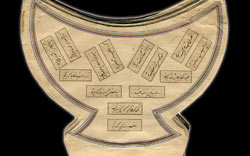Library of the Islamic Parliament of Iran.
Symmetry
Symmetry is a common aspect of Islamicate arts, but at times slight varieties are embedded in seemingly symmetrical pieces, either for the sake of variety itself or because differing sizes of letters and words, which are out of the control of the artist, would disrupt the symmetry of the page. As such, despite their symmetrical appearance, there is rarely perfect symmetry in these works. This is a rare form for a book that has come to be named by its shape, parvāneh-y (‘butterfly-shape’) or qaṭ‘ kashtī (‘vessel-shape’). An archaic usage of kashtī (‘vessel’) is ‘drinking bowl.’



